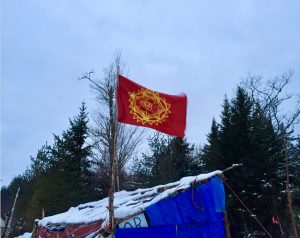‘Working on it. (Dec, 2021)

The flag of the seven traditional districts of Mi’kma’ki at the Last Hope Wildlife Corridor encampment, Jan 2022
In December of 2021, as a descendant of settlers and following the lead of Community Forests International earlier in the fall of 2021, I began to refer to our forest as the “Wabanaki Forest” rather than the “Acadian Forest”.
It’s a process. In my ‘settler circles’, in particular on the board of WRWEO, we started acknowledging that Mi’kma’ki is is “unceded, unsurrendered territory” circa 2015; now such declarations at the beginning of gatherings are routine, at least in many venues.
Logically, if we accept that concept, we should also name and view our forest (and forest region) by the name applied to it by our indigenous peoples, by those who tread so gently on it, while also using it and dependent on it – something we of settler descent are just learning to do (the “treading gently” and “using” parts) and appreciate (the “dependent” part).
‘Acadian Forest” was not a universally applied name for the forest region…
Below are some of the references I am looking at as I develop this page.
Puktewei: Learning from Fire in Mi’kma’ki (Mi’kmaq Territory)
Shalan Joudry, MES thesis, Dalhousie University, 2016. “…as I researched the ecological descriptions of our Mi’kmaw homeland and saw the map delineating the Acadian Forest Region, I noticed the striking resemblance of this area to what we in our Eastern Indigenous communities call the Wabanaki Confederacy territory. Mi’kmaw historian Daniel Paul explains that through time, strong political alliances were formed by similar and neighbouring peoples. East of the Iroquois nations, the peoples who made up the Wabanaki group were of Algonquin families of close geography and cultural family (Assembly of Nova Scotia Mi’kmaq Chiefs, 2007, p. 12; Paul, 2006, p. 12; Speck, 1915)
Places and their names matter to people whose identity is rooted in a particular area. As Kovach (2009, p. 61) writes, “Place links present with past and our personal self with kinship groups. What we know flows through us from the ‘echo of generations,’ and our knowledges cannot be universalized because they arise from our experience with our places. This is why name-place stories matter: they are repositories of science, they tell of relationships, they reveal history, and they hold our identity…
5.6 RE-PRESENTING THE WAPANE’KATI FOREST REGION
When I look again at the maps identifying the distribution of the current Acadian Forest range and the lands of the Wapane’kati (known as the Wabanaki Confederacy), I am again struck by the similarities in the boundaries (see Figure 9).”
A river runs through it: an archaeological survey of the Upper Mersey River and Allains River in southwest Nova Scotia
By Benjamin C. Pentz. MA thesis, Archaeology Unit, Department of Anthropology, Faculty of Arts, Memorial University of Newfoundland October 2008 Abstract: New archaeological evidence from the Mersey and Allains Rivers in southwestNova Scotia has enabled historic use of this traditional Mi’kmaq canoe-route to be extended back into the pre-Contact Period. The 2006 Upper Mersey/Allains River Corridor Archaeological Survey has bridged a gap in the archaeological record by building on previous investigations from the southern half of the Mersey River, and limited work on the Allains River. A continuous line of pre-Contact sites now extends through the interior of southwest Nova Scotia, linking the Bay of Fundy and the Atlantic coast. The association of these sites with modern portage trails and the presence of imported Bay of Fundy lithics across the route confirm these waterways formed a travel corridor during the Middle-Late Woodland Period (ca 2,000-450 BP). Additional evidence also indicates most of the route has been used for at least 5,000 years. The results of this survey have provided the basis for more wide ranging discussions of landuse and seasonal settlement patterns of the Mi’kmaq and their ancestors in the region.
Mi’kmaw Theses Online
Cape Breton University/Indigenous Affairs/ Mi’kmaq Resource Centre
The Wabanaki Forest
By Rebecca Jacobs on Community Forests International, Posted on October 26, 2021
“You may have noticed that over the past year, we have begun to refer to the forest in the Maritimes as the Wabanaki-Acadian Forest, or simply the Wabanaki Forest. You may be wondering where this name comes from or why we’ve made this change.
In Canada, climate justice cannot be separated from Indigenous reconciliation and the work of decolonization. That is why Community Forests International is continually learning ways to centre Indigenous justice within our work to protect and restore these special forests — all while working to deepen our partnerships with Indigenous Nations, organizations, and communities.
“New Brunswick is unceded, unsurrendered territory. So when we talk about the natural forest, it’s the Wabanaki forest. It’s not the Acadian forest.”
— Steve Ginnish, Mi’gmawe’l Tplu’taqnn Inc.Language has been and continues to be used as a tool of colonization–but language can also be a tool for reconciliation. Using Indigenous place names is one way in which Indigenous peoples are reclaiming the land from settler states — and is a way all people can honour the land and the Indigenous Nations who have called it home since time immemorial. Read More
Settler Nomenclature for the region
The Hemlock–White Pine–Northern Hardwood Region of Eastern North America
G. E. Nichols Source: Ecology , Jul., 1935, Vol. 16, No. 3 (Jul., 1935), pp. 403-422
WED Halliday, 1937. A forest Classification for Canada
Kings Printer, Ottawa. I believe this is the first use of ‘The Acadian Forest Region”. It applied only to land within Canada. View Map | View Extract from Doc
